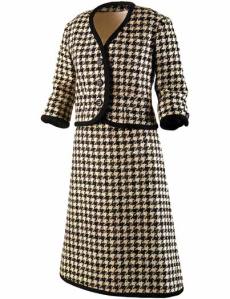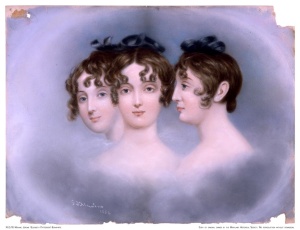
Houndstooth Suit created by Bob Bugnand and worn by Jacqueline Kennedy via The John F. Kennedy Presidential Library and Museum
The third day of the symposium started off with presentations that had a central theme of ingenuity and the different forms ingenuity takes. Ariele Elia, curator at the Museum at FIT and a FIT graduate, gave the first presentation and focused on copyright law and fashion. The next presentation was given by David E. Lazaro, costume curator at Historic Deerfield, and discussed New England’s adoption of Dior’s New Look style. And lastly Susan Neill, independent scholar and museum consultant, gave a much needed biography of Bob Bognand’s couture and ready to wear career. Elia, Lazaro, and Neill presented on the concept of ingenuity which is not often discussed allowing for familiar subjects to be re-explored, like copyright and the New Look.
First Elia gave an introduction to copyrights throughout fashion history. The copying of high fashion objects was a legal practice and still is today. Elia, in conclusion to her presentation, proposed solutions to protecting intellectual property. She posed the question: Do the counterfeit copies of high fashion objects dilute or popularize the original/genuine work.
Lazaro emphasized the importance of the dissemination of idea of the New Look skirt from an exclusive garment to the the uniform of a New England college student. He thought critically about the definition of the New Look, how the silhouette changed in New England, and what the advertisements could offer as source materials to interpret the effect of the New Look on the inhabitants of New England. As a student I thought his approach was simplistic but necessary.
With a fashion history biography Neill stressed the dynamism of Bob Bugnand to transition and thrive as a designer when many of his colleagues closed up shop after the 1960s. She used extant garments and Bugnand’s design archive at FIT to articulate his marketing savvy at a time when couture houses were rapidly closing.

Portrait of Elizabeth Patterson Bonaparte, George D’Almaine after Gilbert Stuart, 1856, Maryland Historical Society, Gift of Mrs. Charles Joseph Bonaparte, xx.5.78
The rest of the day was dedicated to exploring the Maryland Historical Society (MdHS). As a native Marylander I was excited to see the new exhibits and the upgrades to their facilities. The exhibition most interesting to a fashion and textiles historian is entitled: “Woman of Two Worlds:” Elizabeth Patterson Bonaparte and Her Quest for an Imperial Legacy. The exhibition highlights Bonaparte’s live and includes several extant textile objects and a few garments which were in the permanent collection. When not viewing the permanent exhibitions at the (MdHS) many symposium goers snuck in some research at their library, myself included. I focused my energy on preliminary studies on sumptuary law and its effect on slave dress. The symposium has worked its magic to inspire new scholars and students!





